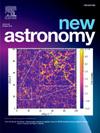在变色龙-穆斯卡黑云复合体中诊断恒星形成
IF 2.1
4区 物理与天体物理
Q2 ASTRONOMY & ASTROPHYSICS
引用次数: 0
摘要
我们提出了一个全面的变色龙-穆斯卡黑云复合体的年轻恒星普查。利用盖亚DR3数据在12°×12°的天空区域搜索天体测量成员,借助2MASS和ALLWISE红外颜色对盘状天体进行辅助,我们不仅发现了已知的与主云相关的成员,还发现了首次发现的云间候选成员。我们确认Cha I在starbirth活跃,有200多名会员。Cha II拥有大约50个成员星,其中3个位于Cha III的北部,本身没有任何恒星形成活动。亚星团Cha I South的平均距离为~ 189 pc,比Cha I North (~ 192 pc)稍近,而Cha II则更远,为~ 198 pc,形成了一个距离序列。等时线拟合表明Cha I和Cha II的年龄一致,约为3myr,表明恒星形成于同一时期。我们的工作证实了Musca灯丝中缺乏成熟的年轻恒星。偶然地,在前景(~ 110 pc)中,一些λ Cha或LCC关联的成员被投影到我们的研究领域;它们是更进化的前主序层天体或矮星,年龄分布在5- 20myr。在我们的数据中还发现了UPK 569星团的一部分,它比变色龙云更古老(~ 30my),距离更远(~ 250pc)。对东南方向约10度的两个独立星云——Cha- east I和Cha- east II的分析发现,没有发现年轻的恒星,这支持了Cha I和Cha II标志着scoc - cen OB协会最新触发恒星形成序列的结束。本文章由计算机程序翻译,如有差异,请以英文原文为准。
Diagnozing star formation in the Chamaeleon–Musca dark cloud complex
We present a comprehensive young stellar census of the Chamaeleon–Musca dark-cloud complex. Searching in a sky area using Gaia DR3 data for astrometric membership, aided by 2MASS and ALLWISE infrared colors for disk-bearing objects, we have found not only members known to be associated with main clouds, but also inter-cloud candidates discovered for the first time. We confirm that Cha I is active in starbirth with more than 200 members. Cha II harbors some 50 members, among which three are projected in northern Cha III, which itself lacks any star-forming activity. The subcluster Cha I South is at an average distance of 189 pc, slightly nearer than Cha I North at 192 pc, whereas Cha II is farther at 198 pc, forming a distance sequence. The isochrone fitting indicates a consistent age of about 3 Myr for Cha I and Cha II, suggesting coeval star formation. Our work confirms the Musca filament with the paucity of fully grown young stars. Serendipitously, in the foreground (110 pc), some members of Cha or LCC associations are projected in our studied field; they are more evolved pre-main sequence objects or dwarfs with an age spread of 5-20 Myr. Also detected in our data is a part of the cluster UPK 569 older (30 My) and farther (250 pc) than Chamaeleon clouds. An analysis of two separate clouds some 10 deg to the south-east, Cha-East I and Cha-East II, uncovers no young stars, lending support that Cha I and Cha II mark the end of the sequence of the latest episode of triggered star formation by the Sco-Cen OB association.
求助全文
通过发布文献求助,成功后即可免费获取论文全文。
去求助
来源期刊

New Astronomy
地学天文-天文与天体物理
CiteScore
4.00
自引率
10.00%
发文量
109
审稿时长
13.6 weeks
期刊介绍:
New Astronomy publishes articles in all fields of astronomy and astrophysics, with a particular focus on computational astronomy: mathematical and astronomy techniques and methodology, simulations, modelling and numerical results and computational techniques in instrumentation.
New Astronomy includes full length research articles and review articles. The journal covers solar, stellar, galactic and extragalactic astronomy and astrophysics. It reports on original research in all wavelength bands, ranging from radio to gamma-ray.
 求助内容:
求助内容: 应助结果提醒方式:
应助结果提醒方式:


